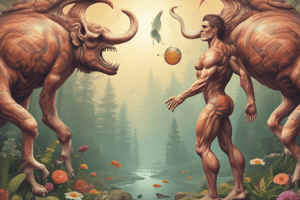Podcast
Questions and Answers
What is the primary reason for the evolution of toxic chemicals in flowering plants?
What is the primary reason for the evolution of toxic chemicals in flowering plants?
- To compete with other plant species
- To enhance their own reproduction
- To prevent herbivores from eating them (correct)
- To attract pollinators
What is the name of the type of mimicry where the mimic is not as well-defended as the model?
What is the name of the type of mimicry where the mimic is not as well-defended as the model?
- Batesian mimicry (correct)
- Symbiotic mimicry
- Mullerian mimicry
- Mutualistic mimicry
What is the primary benefit of pollen for insects?
What is the primary benefit of pollen for insects?
- It allows insects to reproduce more efficiently
- It provides a means for insects to communicate with each other
- It helps insects to navigate their environment
- It serves as a source of food for insects (correct)
What is the term for the relationship between flowering plants and their pollinators?
What is the term for the relationship between flowering plants and their pollinators?
What is the term for the process by which one species evolves in response to another species?
What is the term for the process by which one species evolves in response to another species?
What is the primary difference between Batesian and Mullerian mimicry?
What is the primary difference between Batesian and Mullerian mimicry?
What is the term for the phenomenon where one species resembles another species to gain a survival advantage?
What is the term for the phenomenon where one species resembles another species to gain a survival advantage?
What is the primary reason for the evolution of monarch caterpillars' ability to eat toxic milkweed plants?
What is the primary reason for the evolution of monarch caterpillars' ability to eat toxic milkweed plants?
What is the specific type of mimicry exhibited by the harmless Baja Mountain kingsnake and the milksnake?
What is the specific type of mimicry exhibited by the harmless Baja Mountain kingsnake and the milksnake?
What is the primary benefit of the mutualistic relationship between flowering plants and their pollinators?
What is the primary benefit of the mutualistic relationship between flowering plants and their pollinators?
Flashcards are hidden until you start studying
Study Notes
Evolution: Historical Background
- In the 1700s, the origins of life were predominantly explained by Genesis and Aristotle.
- Any views opposing these beliefs were labeled as heresy.
- Key concepts that gained acceptance included uniformitarianism, Earth's age, extinction of species, and evolutionary changes between species.
- No clear mechanism was proposed for the process of evolution at that time.
Jean-Baptiste de Lamarck
- Proposed the inheritance of acquired characteristics; believed organisms develop new traits based on needs and pass down these traits to offspring.
- Example: Ancestral short-necked giraffes supposedly stretched their necks to access higher foliage.
Genetic Variation
- Critical for adaptation, biodiversity, and survival amid environmental changes; lack of variation increases extinction risk.
- Genetic variation encompasses potential for change in genetic structure and maintenance of divergent populations.
Protein Gel Electrophoresis
- Uses starch, polyacrylamide, or agarose to prepare gels for analyzing alleles.
- Reveals genetic variation through allozymes, distinguishing between monomorphic (uniform alleles) and polymorphic (varied alleles) samples.
Hardy-Weinberg Equilibrium
- Populations can be in equilibrium when:
- No natural selection, mutation, or migration occurs.
- Population size is large and mating is random.
- Implications of equilibrium:
- Constant allele frequencies over generations.
- Predictable genotype frequencies based on allele frequencies.
Changes in Genetic Structure
- Influenced by factors including mutation, migration, natural selection, genetic drift, and non-random mating.
- Mutations introduce new alleles, with varying effects based on environmental conditions.
- Sexual recombination increases genetic diversity within populations, while diploidy can mask variation.
Balanced Polymorphism
- Refers to the stable coexistence of multiple phenotypes within a population.
- Heterozygote advantage exemplifies this, where individuals with mixed alleles have a survival advantage.
- Co-evolution illustrates interdependent evolutionary changes, such as between host and parasite relationships.
Natural Selection and Symbiotic Relationships
- Natural selection remains the key driver for adapting organisms to their environments.
- Example: Mutualistic relationships between flowering plants and pollinators, where both benefit from the interaction.
- Evolution of plant defenses against herbivores leads to adaptations in herbivores, exemplified by monarch caterpillars that consume toxic plants.
Mimicry
- Occurs when one species resembles another to gain survival benefits.
- Batesian mimicry: A harmless mimic resembles a defended model.
- Müllerian mimicry: Both the mimic and the model are defended, benefiting from shared warning signals.
- Examples include the Baja Mountain kingsnake mimicking the venomous coral snake, and the queen butterfly resembling the distasteful monarch butterfly.
Studying That Suits You
Use AI to generate personalized quizzes and flashcards to suit your learning preferences.




